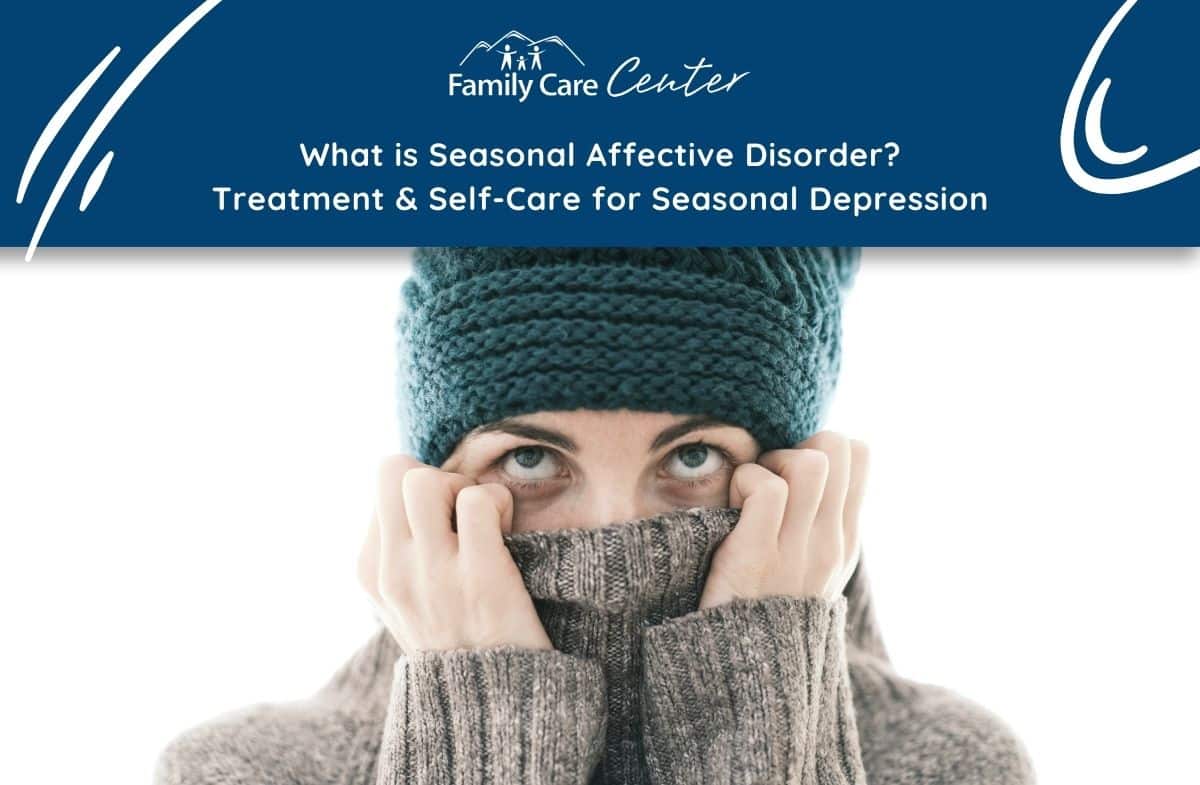If your mood changes as the days get shorter or the temperatures drop, you may have more than just the “winter blues.”
Seasonal changes can affect our mental well-being, potentially leading to seasonal affective disorder (SAD), also sometimes referred to as seasonal depression or winter depression. This condition is when mood and energy levels change due to less sunlight in the fall and winter. The decrease in natural light during the winter months can disrupt your body’s circadian rhythm and influence the production of essential brain chemicals, contributing to the onset of depression and SAD symptoms.
Use this article to understand the symptoms of seasonal affective disorder and discover effective treatments and self-care techniques for seasonal depression.
Key takeaways about seasonal affective disorder (SAD)
- SAD is a type of seasonal depression that happens during a certain season of the year— often in fall and winter.
- There is no clear cause of SAD. Less sunlight, natural production of vitamin D, and shorter days are thought to be linked to a chemical change in the brain and may be part of the cause of seasonal affective disorder (SAD).
- SAD may be diagnosed after a careful mental health exam and medical history done by a psychiatrist or other mental health professional.
- Seasonal winter depression is most often treated with light therapy, psychotherapy and, in some severe cases, antidepressants.
- Self-care activities such as natural sunlight, exercise, meditation and sticking to a routine can help with seasonal winter depression.
What causes seasonal affective disorder?
The direct cause of seasonal affective disorder is unknown. However, as mentioned above, less sunlight and shorter days are thought to be linked to a chemical change in the brain and may be part of the cause of SAD.
When the sun begins to set earlier, our bodies experience less natural light, which can cause a decline in vitamin D, serotonin and dopamine levels, the body’s “feel good” chemical, in our brains. This can create a delicate imbalance, disrupting our mood and energy levels.
Reduced levels of serotonin
Studies indicate that people with SAD, especially winter-pattern SAD, have reduced levels of vitamin D and possibly serotonin. Research also suggests that sunlight affects levels of molecules that help maintain normal chemical levels. Shorter daylight hours may prevent these molecules from functioning properly, contributing to decreased serotonin levels in the winter.
Increased levels of melatonin
Additionally, more melatonin is made when the days are shorter and darker. Melatonin is a hormone that is important for maintaining the normal sleep−wake cycle. People with winter-pattern SAD produce too much melatonin, which can increase sleepiness and lead to oversleeping.
Vitamin D and melatonin both play crucial roles in regulating the body’s daily rhythm. When serotonin and melatonin levels change, it can affect daily routines, causing sleep, mood and behavior changes, which are symptoms of seasonal affective disorder.
Seasonal depression symptoms
People with seasonal depression experience common symptoms of major depression. These symptoms include:
- Sadness
- Loss of energy
- Social withdrawal
- Feelings of hopelessness, apathy, or self-loathing
- Difficulty sleeping or sleeping too much
- Suicidal thoughts
- Lack of interest in things that you normally enjoy
- Changes in weight or appetite
How is SAD diagnosed?
If you or someone you know is showing symptoms of SAD, talk to a mental health provider about your concerns. They might ask you some questions to better understand your feelings and see if they align with the criteria for a SAD diagnosis.
To be diagnosed with SAD, a psychiatrist or mental health professional will examine you and review your medical history. It’s not uncommon for a person with SAD to exhibit the symptoms listed in the section above, in addition to having:
- Depressive episodes that occur during specific seasons (winter or summer).
- Episodes that are more frequent during specific seasons than at other times of the year.
Is it SAD or am I just depressed?
If you have noticed significant changes in your mood and behavior when the seasons change, you may be experiencing seasonal affective disorder (SAD).
Talking to a mental health specialist about your concerns is the first step in getting the support and guidance you may need. They can help you navigate through the process with compassion and understanding.
What helps SAD? Seasonal affective disorder treatments
Treatments are available to help people with SAD. Before starting treatment on your own, it’s essential you work with a health care or mental health provider first. They can discuss the benefits and risks of different treatment options and which is best for you. The best light is natural sunlight for about 20-30 minutes a day, but if the weather is too severe, then light box therapy may be an option.
Light therapy for Seasonal Affective Disorder
Light therapy boxes can effectively treat seasonal affective disorder as they mimic outdoor light. It’s thought that this type of light may cause a chemical change in the brain that lifts your mood and eases other symptoms of SAD, such as being tired most of the time and sleeping too much.
According to the Mayo Clinic, it is important for your light box to:
- Provide exposure to 10,000 lux of light.
- Produce as little UV light as possible.
The Mayo Clinic also recommends using the light box:
- For about 20 to 30 minutes within the first hour of waking up.
- Approximately 16 to 24 inches from your face but follow the manufacturer’s instructions about distance.
- With eyes open but not looking directly at the light.
Disclaimer: Light boxes aren’t regulated by the Food and Drug Administration (FDA) for SAD treatment, so it’s important to use them under the guidance of a health care provider and follow the manufacturer’s guidelines. If you’ve been diagnosed with bipolar disorder or you have past or current eye problems such as glaucoma or cataracts, you should not start light therapy without speaking to your health care provider first.
Not sure how to start the conversation? Check out these five tips to get the most out of your mental health care visit.
Therapy for SAD
Psychotherapy, otherwise known as talk therapy or counseling, is beneficial for individuals dealing with seasonal affective disorder. It guides them in adopting new perspectives, modifying behaviors and transforming habits linked to depression.
Cognitive-behavioral therapy (CBT), a specific form of psychotherapy, focuses on empowering individuals to understand, challenge and alter unhelpful thoughts and behaviors. The goal is to enhance emotional well-being by addressing depressive and anxious feelings. Through the structured approach of CBT, individuals develop resilience and acquire skills to navigate the seasonal lows more easily.
Medication for seasonal depression
In addition to exercise and a healthy sleep pattern, first-line supplemental vitamin D or natural foods rich in vitamin D, such as eggs, milk, oily fish and butter, should be attempted. In certain severe situations, antidepressants like selective serotonin reuptake inhibitors (SSRIs) might be recommended to balance neurotransmitter levels in the brain, forming a medical basis for symptom management.
The decision to use medication is a joint decision between the patient and their psychiatric provider. They consider factors such as symptom severity, individual response to treatment and overall health. Medication works alongside therapeutic interventions when deemed suitable, enhancing the overall treatment plan for a more comprehensive approach.
Seasonal affective disorder self-care
When it comes to combating seasonal affective disorder, it’s not just about seeking treatment; you can also empower yourself with self-care activities. Let’s explore some engaging and effective strategies to elevate your well-being during challenging seasons.
Incorporate regular exercise
Exercise stimulates the release of endorphins, often referred to as “feel-good” hormones. These neurochemicals act as natural mood lifters, helping to counteract the depressive symptoms associated with SAD. The increased production of endorphins contributes to a more positive and balanced emotional state.
Regular exercise can also support better sleep by regulating circadian rhythms and promoting a more restful and rejuvenating sleep cycle. The combination of increased energy levels during the day and better sleep quality at night contributes to an overall improvement in daily functioning.
Embrace mindfulness and stress reduction techniques
Mindfulness involves being fully present in the moment without judgment. By being aware of your thoughts and feelings, you can understand how seasonal changes affect your mental state. Acceptance of these feelings, without harsh judgment, is the first step in addressing them. By being aware of seasonal changes, people can become stronger and handle the highs and lows of SAD more effectively.
Similarly, SAD is often exacerbated by stress, and it just so happens that mindfulness is an effective stress reduction technique. Introducing practices like deep breathing exercises and meditation can activate the body’s relaxation response and potentially reduce the physiological and psychological impact of stressors.
Interested in learning more? Check out our four tips for achieving emotional stability and mental balance.
Establish a supportive routine
A well-organized routine is more than just a schedule; it’s your key to stability and emotional well-being. According to the Cleveland Clinic, our bodies appreciate consistency and routine. So, it’s helpful to go to bed at the same time each night and wake up at the same time every morning, even in the winter months when the days are shorter.
By practicing self-care and seeking treatment for seasonal affective disorder, you can overcome challenges and improve your well-being gradually.
Finding the right care plan for seasonal affective disorder
Depression, whether it’s seasonal or not, isn’t something that you have to deal with on your own. Consulting with a mental health professional is a crucial first step to finding the balance and support you need to feel better.
This information was reviewed and approved by Michael Ruttenberg MS, LMFT, AAMFT Approved Supervisor (1/18/24) and Dr. Charles ‘Chuck’ Weber, D.O. FASAM LTC(R) US Army, Board Certified Psychiatrist / Addiction Medicine Board Certified, Chief Medical Officer of Family Care Center (1/22/24).
Photo by Engin Akyurt on Unsplash.





